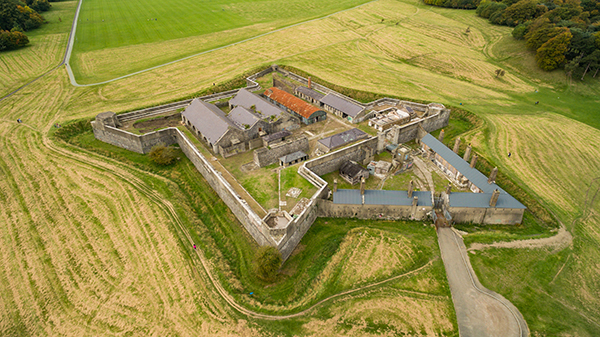MAGAZINE FORT TO BE RESTORED
Published in Issue 2 (March/April 2022), News, Volume 30By Aengus Ó Snodaigh
Like many cooped up at home during the early days of this Covid-19 pandemic, I would venture, when allowed, to the Phoenix Park to stretch my legs, whiling away an hour or so. More often than not, I gravitated to the imposing and decaying Magazine Fort sitting on top of what was known as St Thomas’s Hill. My wanderings reminded me of articles read, research done and a never-completed documentary with which I was involved about a night at Christmas 1939 when an IRA unit ‘liberated’ thirteen truckloads of ammunition from the state’s main armoury.
On Easter Monday 1916, twenty members of Fianna Éireann, under Irish Volunteer officer Paddy Daly, played a football match outside the fort as a ruse to get near the sentries, whom they overpowered as they rushed the guardroom, making it the only British Army military installation to be captured by rebels during the Rising. Mines were laid among what ammunition or weapons were there (the bulk had already been sent to the front as the First World War dragged on), and it took over eight hours before the subsequent blaze was brought under control. One of the sentries was wounded in the operation, while the son of the Officer Commanding, 23-year-old George Playfair, was shot dead as he tried to raise the alarm at nearby houses in Islandbridge.
Built in 1734 on elevated ground above the Liffey and encircled by a dry moat, the Magazine Fort was star-shaped and capable of storing hundreds of tons of gunpowder and other military paraphernalia. Designed by John Corneille Junior, it replaced an earlier, smaller earthwork fort and was on the site of a large house, Phoenix Lodge. It is a defensive fort with commanding views across the park, designed with 5ft-thick walls, ramparts, demi-bastions, ravelins and embrasures to allow greater line of fire on attackers if needed. Cannons were mounted around the walls and, much later, pillboxes with machine-guns were added. As the two occasions when the fort was captured testify, the design proved to be no defence against the human frailty of the sentries.
The Office of Public Works has again announced that works are to begin on restoring it and repurposing it after it was decommissioned by the Defence Forces over 35 years ago. Since then, it has lain abandoned, open to the vagaries of Irish weather, and is now in need of a lot more tender loving care than in 1988.
Never known for their creature comforts, the many British Army installations that ringed Dublin were basic, rough and ready. At the same time they were home not only to the soldiers but also to their families, and the Magazine Fort was no different. And this will, we are told, be captured in the OPW’s plans for a new visitor centre, and maybe a café for weary strollers like me. I know that local architect and singer/collector the late Frank Harte had drawn up plans for the Department of Defence years ago, which came to nought. Perhaps the current architect in charge, Denis Byrne, has been influenced by his detailed plans?

Above: The Magazine Fort in Dublin’s Phoenix Park. Built in 1734 on elevated ground above the Liffey and encircled by a dry moat, the star-shaped fort was capable of storing hundreds of tons of gunpowder and other military paraphernalia.
The nearly two-acre complex will greatly add to the public attractions in the 1,750-acre Park—the deer, the zoo, Farmleigh House, the Papal Cross, the Phoenix monument, the Wellington monument, Ashtown Castle, the People’s Gardens and more. Inside the fort are three massive magazines which had gantries to move the powder kegs back in the day, courtyards, officers’ quarters, guardhouse, bakery, laundry, cookhouse and blacksmith’s forge, along with stables and all that went with ferrying supplies in and out. The scope for the OPW is huge and I wish them well in this endeavour as they make it accessible for all, making use of new technologies, projections, holograms etc. to retell the stories of a once-bustling military installation.
It is sadly ironic that, as we hear this good news, we are also hearing that the developer Hammerson has been granted permission to irreversibly alter the streetscape of Dublin’s Moore Street, ‘the most important historic site in modern Irish history’, where the remnants of the GPO garrison grappled with the decision to surrender.
But let the last word on the fort go to Jonathan Swift. At the time of its construction, he wasn’t impressed by what he considered the excessive cost at a time of large-scale poverty in Dublin:
Now’s here’s a proof of Irish sense
Here Irish wit is seen
When nothing’s left that’s worth defence,
We build a Magazine.
I imagine he would have got a laugh out of the proposal at one stage to establish the government’s emergency bunker there, too.
Aengus Ó Snodaigh is an author, historian and TD for Dublin South Central.
















